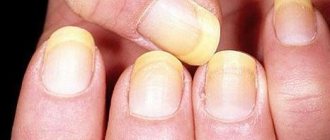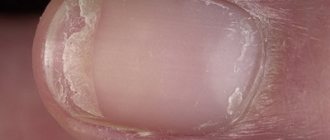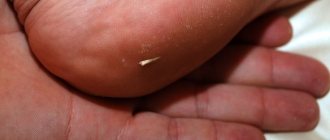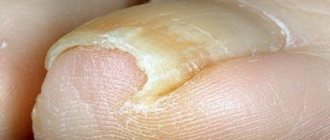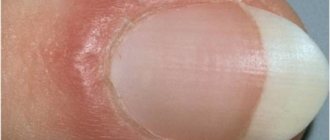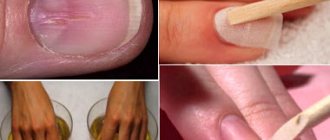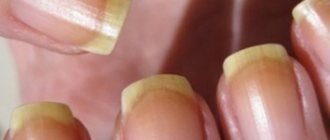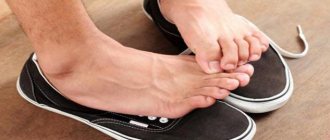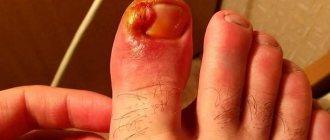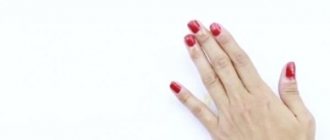Not always, when performing this or that work, we sufficiently protect ourselves.
The precautions that must be taken seem unnecessary or unnatural to us. Hardly anyone wears gloves when preparing food on a cutting board.
But it is in everyday life that we most often have the opportunity to get a splinter , sometimes without even noticing it right away.
A splinter is a painful phenomenon , especially unpleasant when it ends up under the nail, in a place where it is especially difficult to get it out.
Sometimes we do not detect a splinter immediately, but only when suppuration has already begun, since a foreign body caught under the nail most often carries an infection. It is impossible to ignore a splinter: it causes pain and can lead to serious consequences (swelling at the site of contact, suppuration, panaritium, infections, fever).
Splinters must be removed, not forgetting to thoroughly disinfect the affected area.
What types of splinters are there?
There is an opinion that skids can only be caused by wooden objects with a poorly treated surface. This is far from true. Although splinters from wooden objects are the most common, you need to be careful when working with glass, metal shavings, and plants with thorns (especially cacti).
Splinters from wooden objects
When working with gardening tools, it is necessary to protect your hands with gloves, since the cuttings of the tools are not always sufficiently well processed and covered with a protective layer.
By making sudden movements, you can bring a piece of wood under the skin or under the nail. The danger of such a splinter is that dirt gets in along with the foreign body , which without proper attention will certainly lead to decay.
| Splinters from wooden objects are dangerous because they can break when removed. Then the remaining part, sometimes not immediately noticeable, will manifest itself over time as serious complications. |
cactus splinter
Splinters from plants
Not all plants are harmless.
Even when caring for house plants, you should not forget about safety rules.
The spines or thorns may become embedded in the skin or under the nail. Remember that some plants, defending themselves in nature, not only developed “weapons”, but also supplied them with poison.
It is important to note
The causes of a splinter under the nail can be very diverse, ranging from small pieces of wood, fiberglass, metal shavings to plant thorns and thin fish bones.
Usually, a splinter caught under the nail plate causes severe pain not only in the injured area, but throughout the finger and even the hand. If the splinter has gone too deep and the pain is unbearable, or a splinter has appeared under a child’s nail, you should not take the risk of trying to remove it yourself. It is better to immediately seek qualified help from medical professionals who will carry out all the necessary manipulations and the foreign object will be successfully removed from under the nail using painkillers.
Summarizing all of the above, it should be noted that a splinter under the nail is, although not a big, but quite serious injury, so you should not neglect and leave the splinter or try to remove it without following the basic rules of hygiene and disinfection. All this can lead to the formation of inflammatory processes, abscesses under the nail and infection.
Should you see a doctor if you have a splinter?
In most cases, visiting a doctor to remove a splinter from soft tissue is not required: with sufficient processing of the instruments and shallow penetration, it can be removed at home.
| The situation is different if the splinter gets under the nail. It is not easy to get to because the hard nail plate is difficult to move apart to make room for tools. |
It’s good if the edge of the splinter remains visible and does not disappear under the nail . In this case, you can grab the foreign body with tweezers and try to remove it. A splinter under the nail is very painful because the nail plate covers the nerve endings.
You should seek medical help in the following cases:
- It is not possible to remove the splinter on your own because it is deep; surgery is required , sometimes even removing part of the nail plate.
- After trying to remove the splinter on my own, part of it remained under the nail.
- It is imperative to consult a doctor if there is pulsation or visible suppuration and swelling in the affected area.
- If the splinter is from a plant whose poisonous properties you know or even suspect.
- Even if you removed the splinter yourself, but at the site of the lesion you observe a change in the color of the nail plate, deformation of the surface or other visible changes, consult a doctor immediately.
- A splinter under the nail is not only painful, but, without proper attention, can cause more serious illnesses , so seeing a doctor will help avoid unpleasant consequences.
Foreign body extraction methods
If a splinter gets into your finger, it is easy to remove. But there are times when it breaks during extraction and penetrates deep under the nail. If this happens, removing the splinter from the skin or from under the nail is carried out in the following ways:
- Lubricate the affected finger well with iodine and the splinter will dissolve. This method is effective only when only a small foreign body has entered the skin.
- Apply Vishnevsky ointment or Ichthyol ointment to the affected nail. Wrap a bandage on top. After a couple of hours, remove the bandage and check that the foreign body has completely come out.
- If the splinter is deep, dip your finger in ammonia for a couple of minutes. Then wrap it with thick cloth. After some time, the foreign body will dissolve.
- Stick a piece of tape or adhesive tape to the affected area and quickly tear it off. In this way, large protruding splinters are successfully pulled out of the skin and nails.
- Add a spoonful of soda to a liter of warm water. Keep your finger with the foreign body in this bath for ten minutes. When the skin steams, the splinter will come out. If this does not happen, it can be removed with tweezers. Soda can be replaced with heated sunflower oil.
You can also lubricate the affected finger and sharp needle with alcohol. Then use a needle to carefully hook the splinter and pull it out.
When the foreign body is completely removed, be sure to treat the wound with an antiseptic.
Foreign body in children
If a splinter has entered under a child's nail, soak the injured finger in a liter of water with grated soap (take half a bar). Such a soap bath will help the foreign body come out faster. Then treat the wound with alcohol or iodine.
ethnoscience
The following folk methods will help you remove a splinter from under your nail:
- add 5 grams of soda or salt to a glass of boiling water, add the same amount of calendula or eucalyptus tincture. Place your finger in the resulting bath for a couple of seconds, then remove it. Repeat lowering and withdrawing your finger for 15 minutes;
- Mix fenugreek and comfrey roots in equal proportions. Pour boiling water over the mixture until you get a thick paste. Apply it to the bandage and wrap it around the affected area of the finger. Change healing compresses every four hours until the splinter is removed;
- treatment with onions also helps to get rid of a foreign body in the finger. Chop the onion, apply it to the wound and wrap it in a bag and a bandage. Change the onion compress every three hours;
- Make a healing ointment from white cosmetic clay and hot water. Apply the ointment to the wound and wrap it with a bandage. Reapply the product every two hours.
The folk recipes described answer the question of how to remove a splinter from under a nail. If the foreign body has remained in the finger for a long time and provoked the development of an inflammatory process, immediately begin treatment to save the finger.
Knowing how to remove a splinter from under a nail, you can perform the procedure painlessly, quickly and successfully. It is important to do all activities under sterile conditions to prevent the development of inflammation and accumulation of pus. If you are not sure that you can cope with a foreign body in your finger on your own, be sure to go to a specialist for help.
Splinter processing, splinter removal tools processing
| If the splinter has entered shallowly under the nail and part of it is accessible, then you can try to remove it yourself. |
!An important condition is the treatment of the affected area and the tools that you will use to remove the splinter.
- Before removing a splinter, be sure to wash your hands thoroughly , this is especially important if the splinter was received during gardening work or repairs, when conditions are far from sanitary.
- Treat the affected area . To do this, apply formic alcohol or a solution of boric acid (2 percent), hydrogen peroxide is also suitable. If you don’t have anything pharmaceutical with you, you can use vodka or cologne.
- Carefully treat the tools you intend to use to remove the splinter. The same products that you used to treat the wound are suitable for treatment. It is better to wipe the tools with moistened cotton pads.
- After successfully removing the splinter, it is recommended to re-treat the affected area , since the foreign object that got under the nail brought with it germs. Under the nail, where air supply is limited, they will develop quite quickly. The infection may not appear immediately and can lead to serious consequences. You can treat the area with brilliant green or iodine.
How to remove a splinter for a child?
If your child picks up a splinter, you should not immediately panic, because you may scare him, and then it will be much more difficult to remove the foreign object. It is recommended to immediately contact a specialist for help, but if this is not possible, you should try to remove the foreign body yourself.
It must be remembered that you must act carefully and quickly, because keeping a splinter under the nail for a long time can lead to suppuration and sepsis.
To remove a foreign object, they most often resort to using improvised means (sewing needle, tweezers) or use traditional medicine.
An easily accessible item for removing a splinter is a sewing needle. Before using it, it is necessary to disinfect the instrument (with alcohol, iodine), then treat the surface with a foreign body with an antiseptic solution (boric acid, cologne). Hands are washed in tap water and soap.
If a child cries, it is necessary to distract him. Then carefully pry the splinter and pull it out. The wound formed after removal of a foreign object is treated with brilliant green, alcohol or another alcohol-containing solution.
It is necessary to carefully remove the foreign object so that its particles do not remain inside.
They also practice removing splinters with the help of skin softening agents (herbal infusions of chamomile, calendula, yarrow, aloe leaf). They apply themselves to the splinter. Then they take tweezers and carefully tear the skin fold around the foreign object to pull it out by the tip. The wound is also treated with an antiseptic (alcohol, iodine). The baby must first be distracted with something so that he does not get scared.
Removing a splinter using tape is one of the effective methods that does not require any preparation. Apply it to the subungual space and sharply tear it off. There should be a splinter on the tape.
Mechanical splinter extraction technology
To remove a splinter from under your nail yourself, try the following:
- Carefully clean all necessary tools (needle, tweezers), wash your hands and treat the surface of the nail plate.
- If the splinter is small, prepare a magnifying glass.
- If the splinter is visible, the edge of the foreign body is sticking out, pick it up with tweezers and pull it at the same angle at which the splinter entered under the nail. Try not to pull with sudden movements , as you may break the splinter: in this case, it will be much more difficult to remove it.
- If the site of penetration of the splinter is difficult to see, you can smear the nail with a weak solution of potassium permanganate. A dark dot or stripe will appear at the site of penetration.
- If possible, before removing the stain from under the nail steam your finger by dipping it in warm water and soda. A slight softening of the nail will help “spread” the nail plate, which will allow the splinter to more easily come out from under the nail.
- After removing the splinter, treat the affected area. If you are in conditions that are far from sanitary, it is better to put a bandage on your finger.
What to do at home
- Wash your hands thoroughly with soap.
- Treat the sore spot with antiseptics - 96° alcohol, hydrogen peroxide or chlorhexidine solution.
- Find the tools you will need at home: this could be a needle, tweezers or small nail clippers.
- We disinfect the selected instruments - wipe them thoroughly with a cotton swab moistened with alcohol and dry them.
- We carry out the procedure in good lighting - during the day, near a window, in the evening - under a table lamp. It would be good to use a magnifying glass if you have one in the house.
- If the tip of the splinter is clearly visible to us and peeks out from under the nail, we take tweezers and carefully, slowly pull out the foreign object at the angle at which it entered.
- If the tip is not visible, carefully insert the end of the needle into the skin and pull the fingertip lower. We must find where this splinter is located and try to push it up to make it easier to pull it out.
If the previous procedures were unsuccessful, it means that the splinter is sitting too deep and more careful preparation and time will be needed to pull it out. What to do in this case? You will need to steam your finger in hot water, where soda and table salt have previously been diluted. It is necessary to apply bandages with Vishnevsky or Ichthyol ointments for a long time for 6–8 hours. They help to tighten the embedded foreign body and, if there is already purulent contents, they will draw everything out and prevent the subsequent development of infection and inflammatory process. You can also soak your finger in alcohol or vodka for 30 minutes.
After successfully removing the splinter , you need to treat your finger with hydrogen peroxide or chlorhexidine solution, dry everything, apply a bandage with Vishnevsky ointment and bandage the sore finger. It is recommended to do dressings once a day for about 5–7 days. If a wound remains after the procedures, you need to treat your finger with iodine or a solution of brilliant green. There is also a good modern analogue of iodine - Betadine solution. Unlike iodine, it is not alcoholic, but aqueous. Therefore, it does not bake and does not cause unpleasant sensations. It is used even by young children, for whom it is much more difficult to treat a wound than adults. These solutions will dry the wound well and help a speedy recovery.
Traditional methods for removing splinters
- You can prepare a soap solution - it will help soften the skin at the site of the splinter. To do this, grate the soap and dilute it in 0.5 liters of hot boiled water. Keep your finger in this solution for half an hour.
- Decoctions of medicinal herbs also help: chamomile, calendula, string, plantain. They have antibacterial properties and will help relieve finger inflammation.
- We dilute the healing clay with water to a paste and apply it to the finger. Leave it on for 10-15 minutes and then rinse it off under warm water.
- Finely chop the onion and apply it to the wound on a bandage. It will help us pull a small splinter out and it will be better visible.
- Soak the crumb of black bread in water, squeeze it out, make a paste out of it, add salt and put it all on a bandage, secure it with a bandage and leave it for several hours. It is believed that this compress helps to better draw out glass and metal splinters.
- Lubricate the sore finger with pine resin (any tree resin will also work). You can also replace resin with tar; you can buy it at a pharmacy. It has a specific smell, but has many useful and medicinal properties: it perfectly relieves inflammation, swelling, relieves pain, and promotes faster tissue healing. It is very affordable and can be found in any pharmacy.
- We use transparent tape or adhesive tape to remove it - glue it to the end of the splinter and remove it with a quick movement of the hand. You need to act very carefully so as not to accidentally break off a splinter.
- You can use hot wax from a paraffin candle or special wax strips for depilation. To do this, heat the wax and drip it onto the affected surface. After the wax has cooled, remove it along with the splinter. The tip of the foreign body should come out. Before doing this, you can take a bath with sea salt and baking soda - this will help soften the skin around the nail bed.
- Take an aloe leaf, wash it thoroughly, cut it so that the pulp is visible and apply it to your finger for 2-3 hours. Secure the finger with a bandage or clean cotton cloth.
- A regular banana peel will also work - place the inner surface of the peel on your finger and leave for a long time.
Folk remedies for removing splinters
To remove a splinter from under a nail, you can make compresses: 1. Add a teaspoon of vodka to a tablespoon of finely grated cabbage . Place the resulting mass in a sterile bandage and apply it to the splinter. After 2-3 hours, the splinter should pull out from under the nail. If the splinter is deep, the procedure must be repeated several times. 2. A compress of onions will help pull out the splinter , which must be grated until mushy on a fine grater. 3. An aloe leaf will help pull out the splinter. It is necessary to cut off part of the leaf, revealing its pulp. Apply the pulp to the affected area and bandage. Keep the compress for 2-3 hours . Repeat as necessary. 4. To pull out a splinter, you can apply a compress of grated potatoes.
wax will help remove the splinter
What to do if the splinter is deep under the nail
It is not always easy to remove a foreign object, especially if it has managed to penetrate deeply, and you cannot pick up the tip with either a needle or tweezers. This often happens if a girl performed the manipulation illiterately, pushing the splinter even deeper.
If a problem is discovered in a child, it is recommended to contact a surgeon to administer local anesthesia and perform a mini-surgery to remove the defect.
When processing yourself, use one of the following methods:
- Apply ichthyol ointment to your finger and wrap it with cotton wool, fixing it for 2 hours. After this, remove the compress and remove the splinter. The product will relieve inflammation and increase the local pain threshold;
- Use Vishnevsky ointment. It will help stretch the body higher, so you can hook it with tweezers or a needle;
- Lotion with vegetable oil. Heat the oil in the microwave to the optimum temperature and immerse your finger in it for 15 minutes. This should reduce inflammation and bring the body closer to the surface of the skin, making it easier to remove.
Sometimes it is recommended to first use a steaming salt or soda bath to eliminate inflammatory processes and speed up the healing of the epidermis.
In advanced cases, when severe suppuration begins, the girl should contact a surgeon to carefully perform the procedure, removing the splinter from under the nail bed, preventing further complications.
Wax and resin for removing splinters from under the nail
If the tip of the splinter is slightly visible, but it is impossible to pry it off, it is recommended to use resin or wax .
- Apply heated wax or resin to the nail and leave until completely hardened.
- Afterwards, carefully remove the wax or resin in the direction of the splinter’s entrance.
- The splinter should attach to the wax or resin and come out when it is removed.
- You can soak your finger in a bath of soap or soda before applying wax or resin: this will soften the nail.
Folk tips and recipes if you get a splinter under your nail
Before deciding how to remove a splinter from a nail, you should first treat the injured area with iodine. It is better to do this several times, thereby thoroughly disinfecting the wound. Perhaps, if the splinter was very small, after such treatment it will come out or dissolve on its own, but if not, you can use one of the folk recipes.
Recipe No. 1
If you have a splinter under your nail and you don’t know how to get it out, try preparing a compress. To do this, take dry comfrey or fenugreek root and grind it into a powder, which you mix with hot water to form a thick paste-like consistency.
If, after injuring your finger and nail, you did not treat the wound with anything, do it with iodine or alcohol, and then apply a compress with the prepared mixture and firmly fix it on the affected area. Change the bandage every 3-4 hours until the splinter becomes accessible, then carefully remove it with thin tweezers and treat the wound with calendula ointment.
Recipe No. 2
You can prepare a compress using regular onions. To do this, take one onion, peel it and chop it using the finest vegetable grater. Apply the resulting pulp to the injured area, having first disinfected it (with peroxide, alcohol, iodine, etc.), cover the compress on top with a small piece of plastic wrap and secure with a bandage.
Change the applied compress at least every three hours, and be sure to treat the wound with a disinfectant each time.
Recipe No. 3
This recipe will tell you how to remove a splinter from a nail using pine resin. It is necessary to apply this product to the areas around the nail plate, as well as on it and, if possible, under the nail. You should first treat the wound with alcohol or any other disinfectant. Next, bandage your finger tightly and leave it for 6 hours, after which remove the remaining oleoresin using a cotton or gauze swab dipped in turpentine or alcohol.
As soon as the splinter becomes accessible, try to carefully remove it with a suitable instrument (tweezers, tweezers, needle), which must first be treated with a disinfectant solution.
Recipe No. 4
You can also take a leaf of white cabbage, wash it thoroughly, dry it, and then grind it into a paste.
Next, add one tablespoon of alcohol or regular vodka to the cabbage pulp, mix and spread the prepared product on a sterile gauze napkin, which you then wrap around the finger and nail affected by the splinter. Place a clean, dry cloth on top and wrap the compress well with a bandage. Change the cabbage compress to a fresh one every three hours and stop the procedure only after the splinter becomes accessible.
Recipe No. 5
If there is a splinter embedded under your nail, the following recipe will tell you how to remove it using a soap bath. Finely grate regular baby soap to make 5 tablespoons, and mix the shavings with a liter of boiling water. When the soap has dissolved, carefully lower the injured finger into the bath and keep it in the soap solution for several minutes.
Repeat the procedure until the liquid has cooled. If after this the splinter does not appear, apply one of the compresses suggested above on top of the injured area.
Complications after removing a splinter from under the nail
A splinter caught under a nail is dangerous due to its complications.
It is not always possible to remove it completely the first time. Even a small fragment left under the nail can lead to decay.
After removing the splinter, it is important to carefully treat the affected area and monitor the condition for several days . If you feel throbbing or pain, be sure to consult a doctor , as these are the first symptoms of possible complications. Penetrating under the nail, the splinter brings with it an infection that quickly spreads. If you notice swelling or redness, contact your doctor. Sometimes delay leads to the need for surgical intervention, including removal of the nail plate.
